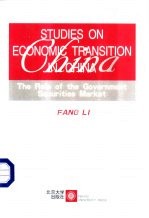

中国经济转型研究 政府证券市场的作用PDF电子书下载
- 电子书积分:9 积分如何计算积分?
- 作 者:厉放著)
- 出 版 社:北京:北京大学出版社
- 出版年份:2000
- ISBN:7301044313
- 页数:200 页
List of Figures 1
List of Tables 1
Foreword 1
Acknowledgement 1
Abstract 1
Chapter 1 Introduction 1
1.1 Purpose of the Study 1
List of Charts 1
1.2 The Contribution of the Study 2
1.3 Organization 3
Chapter 2 Literature Review on the Role of the Capital Market during Economic Transition 5
2.1.1 The Reform of the Direct Monetary Control System 6
2.1 A Brief Review of Studies of the Financial System during Economic Transition 6
2.1.2 The Role of the Capital Market during the Transition 8
2.2 Studies on Economic Transition in China 13
2.2.1 Monetary Management and Financial Reform--A Brief Survey 14
2.2.2 The Development of Capital Markets 18
2.3 The Evaluation on the Studies of Economic Transition 20
Chapter 3 The Monetary Institutional Framework in the Centrally Planed Economy 22
3.1 A Unified Banking System 24
3.2 The Relationship between the PBC and MOF 28
3.2.1 Credit Funds and Fiscal Funds 28
3.2.2 The Relations between the Credit Balance and Fiscal Balance 30
3.3 Credit Management--A Comprehensive Credit Plan 31
3.3.1 Object of the Cedit Plan 32
3.3.2 The Form of the Credit Plan 33
3.3.3 Instruments of Implementing the Credit Plan 34
3.3.4 A Supplementary Instrument--The Cash Plan 36
3.4 Loan Principles and Interest Rate 40
3.4.1 Loan Principles 40
3.4.2 The Role of Interest Rate 42
3.5 The System Characteristics and Conclusion 44
Chapter 4 The Monetary Institutional Framework during the Economic Transition 47
4.1 Forming A Framework for the New Monetary Institutional Structure:Movement towards Central Banking 48
4.1.1 Establishment of the Central Bank 48
4.1.2 Restructuring of the Specialized Banks 49
4.1.3 Extended Non-bank Financial Institutions 51
4.1.4 The Major Changes of the Banking System 53
4.2 Monetary Management 54
4.2.1 Monetary Management Framework 55
4.2.2 Intermediate Target and Policy Instruments 57
4.3 Weaknesses of the Existing Monetary Management System 62
4.3.1 The Independence of the Banking System 62
4.3.2 Behavior of State-owned Banks 66
4.3.3 The Role of Interest Rate 67
4.3.4 An Overdraft System between the PBC and MOF 70
4.3.5 Intermediate Target-Credit Aggregate or Money Supply 72
4.4 Conclusion 75
Chapter 5 Institutional Analysis of the Government Securities Market in China 77
5.1 The Background and Development of the Government Securities Market 78
5.1.1 The Background to the Issuing of Government Securities 79
5.1.2 The Government Securities:Types,Volume and Coupon Rates 82
5.2 The Characteristics of the Primary Market 86
5.2.1 Diverse Bonds 86
5.2.2 The Model of Government Securities Issues 86
5.2.3 The Coupon Rate of Treasury Bond 89
5.2.4 The Treasury Bonds Discount 89
5.2.5 The Securities Redemption 90
5.3.1 Black Markets:July 1981 to April 1988 93
5.3 The Development of Secondary Market 93
5.3.2 Grey Markets:April 1988 to October 1990 95
5.3.3 White Markets:October 1990 to 1992 100
5.3.4 Exogenous Shocks Affected on the Market in 1991 and 1992 102
5.4 Conclusion 107
Chapter 6 An Empirical Analysis of the Government Securities Market 114
6.1 Methodologies 115
6.2 Data Description 115
6.3 Scope of the Empirical Investigation:Cities and Bonds 116
6.4 An Empirical Analysis of Geographical Patterns of Government Bond Yields 118
6.4.1 Bond Yield in Different Cities 119
6.4.2 Harmonization 120
6.4.3 Transmission of Monetary Policy 124
6.5 An Empirical Analysis of Price Spread during 1990 to 1992 125
6.5.1 Aggregate Price Spread of Bonds 126
6.5.2 A Comparison of Price Spread of Bonds from 1990 to 1992 127
6.6 Statistical Evidence on the Market Integration 130
6.6.1 A Test of the Convergence of Bond Yields between Shanghai and Regional Markets 130
6.6.2 Empirical Results and Implication 138
6.6.3 A Test of Market Integration 139
6.6.4 A Test of Institutional Contribution to Market Integration 142
6.7 Conclusion 145
Chapter 7 The Role of the Government Securities Market during the Economic Transition 168
7.1 Monetary Policy Framework in the Market Economy 168
7.1.1 Discretionary Monetary Policy 169
7.1.2 Monetarist s Policy Rules 170
7.1.3 Recent Changes in Monetary Policy Framework 171
7.2 The Contribution of the Government Securities Market to Reforming Monetary Management in China 172
7.2.1 Removal of Direct Instruments 172
7.2.2 Libralization of Interest Rates 174
7.2.3 Foster Competition 176
7.2.4 Altering th Overdraft System between the PBC and MOF 177
7.2.5 Helping the Development of the Capital Market 178
7.3 Summary and Conclusion 179
Reference on Financial Laws,Decrees,Regulations and Documents 184
Reference 187
Postscript 199
- 《中国当代乡土小说文库 本乡本土》(中国)刘玉堂 2019
- 《异质性条件下技术创新最优市场结构研究 以中国高技术产业为例》千慧雄 2019
- 《中国铁路人 第三届现实主义网络文学征文大赛一等奖》恒传录著 2019
- 《莼江曲谱 2 中国昆曲博物馆藏稀见昆剧手抄曲谱汇编之一》郭腊梅主编;孙伊婷副主编;孙文明,孙伊婷编委;中国昆曲博物馆编 2018
- 《中国制造业绿色供应链发展研究报告》中国电子信息产业发展研究院 2019
- 《中国陈设艺术史》赵囡囡著 2019
- 《信息系统安全技术管理策略 信息安全经济学视角》赵柳榕著 2020
- 《《走近科学》精选丛书 中国UFO悬案调查》郭之文 2019
- 《清至民国中国西北戏剧经典唱段汇辑 第8卷》孔令纪 2018
- 《中国少数民族唢呐教学曲选》胡美玲编 2019
- 《大学计算机实验指导及习题解答》曹成志,宋长龙 2019
- 《指向核心素养 北京十一学校名师教学设计 英语 七年级 上 配人教版》周志英总主编 2019
- 《大学生心理健康与人生发展》王琳责任编辑;(中国)肖宇 2019
- 《大学英语四级考试全真试题 标准模拟 四级》汪开虎主编 2012
- 《大学英语教学的跨文化交际视角研究与创新发展》许丽云,刘枫,尚利明著 2020
- 《北京生态环境保护》《北京环境保护丛书》编委会编著 2018
- 《复旦大学新闻学院教授学术丛书 新闻实务随想录》刘海贵 2019
- 《大学英语综合教程 1》王佃春,骆敏主编 2015
- 《大学物理简明教程 下 第2版》施卫主编 2020
- 《指向核心素养 北京十一学校名师教学设计 英语 九年级 上 配人教版》周志英总主编 2019
